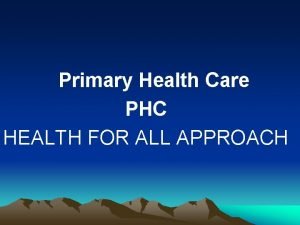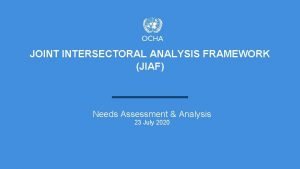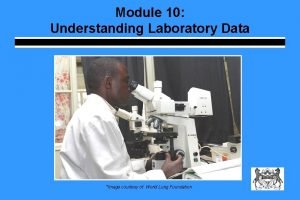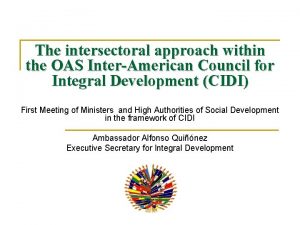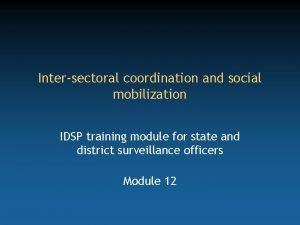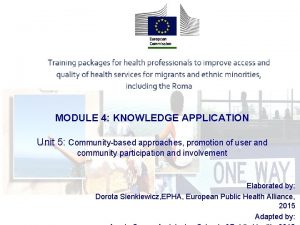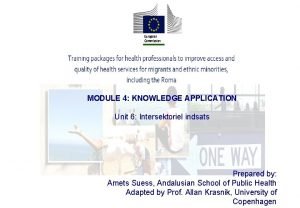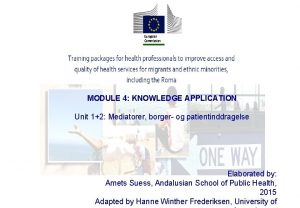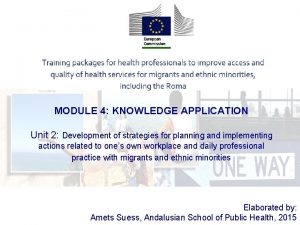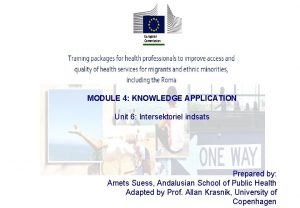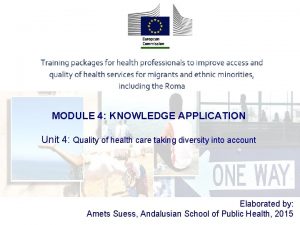MODULE 4 KNOWLEDGE APPLICATION Unit 6 Intersectoral Approach














- Slides: 14

MODULE 4: KNOWLEDGE APPLICATION Unit 6: Intersectoral Approach Elaborated by: Amets Suess, Andalusian School of Public Health, 2015

Outline of the Session • Presentation: “Intersectoral Approach” • Activity: “Mapping an Intersectoral Action”

Intersectoral Action: Concept Intersectoral action for health could be defined as a coordinated action that explicitly aims to improve people’s health or influence determinants of health. Intersectoral action for health is seen as central to the achievement of greater equity in health, especially where progress depends upon decisions and actions in other sectors. (Ståhl, et al. 2006) [W]e understand “intersectoral action for health” to refer to actions undertaken by sectors outside the health sector, possibly, but not necessarily, in collaboration with the health sector, on health or health equity outcomes or on the determinants of health or health equity. (WHO, Public Health Agency of Canada 2008: 2) Ståhl, et al. 2006; WHO, Public Health Agency of Canada 2008.

Intersectoral Action: Conceptualization • Intersectoral action is conceptualized as related to: ü Models of health inequities and social determinants of health. ü “Health in All Policies” framework. • Different levels of development and application. • Participation of multiple institutions and stakeholders. Health in All Policies (Hi. AP) is a policy strategy which targets the key social determinants of health through integrated policy responses across all relevant policy areas. (CHAFEA 2014: 21) CHAFEA 2014; Marmot 2013; Mc. Qeen et al. 2012; Ministry of Health and Social Policy of Spain 2010; Ståhl, et al. 2006; Vervoordeldonk, et al. 2013; WHO 2008, 2010, 2011. .

Intersectoral Action: Opportunities and Limitations • Opportunities ü ü Development of synergies. Achievement of intersectoral co-benefits. Enhancement of equity in health. Reduction of geographical inequalities. • Limitations ü ü ü Difficulties in the coordination among stakeholders. Costs of intersectoral interventions. Difficulties in measuring cost-benefits balance. Limited implementation on a local level due to a reduced priorization at a European, national or regional level. Difficulties in the improvement of social determinants of health. CHAFEA 2014; Marmot 2013; Mc. Qeen et al. 2012; ; Ministry of Health and Social Policy of Spain 2010; Ståhl, et al. 2006; Vervoordeldonk, et al. 2013; WHO 2008,

Intersectoral Action: Strategies • Strategies ü Improving a political and institutional recognition of intersectoral action. ü Including long-term perspectives. ü Assuring continuity, assessment and follow up. ü Promoting community participation and empowerment. ü Adapting intersectoral actions to the political, economic and cultural context. CHAFEA 2014; Marmot 2013; Mc. Qeen et al. 2012; ; Ministry of Health and Social Policy of Spain 2010; Ståhl, et al. 2006; Vervoordeldonk, et al. 2013; WHO 2008, 2010, 2011.

Intersectoral Action: Relevance within Health Inequalities Actions • Revision of 64 actions addressing health inequalities conducted within the EU First and Second Health Programme (CHAFEA 2014) ü “Health in All Policies (Intersectoral Action)” as the less frequent type of intervention. ü Increasing consideration of intersectoral actions in the EU Second Health Programme. ü Migrants and ethnic minorities as a relevant target group. CHAFEA 2014. Source of figures: CHAFEA 2014: 22, 24.

Intersectoral Action: Relevance for Health Care and Health Policies Addressed to Migrants and Ethnic Minorities • Multi-sectoral dimension of migrant and ethnic minorities health: Economic, political and social character of the determinants of migrants’ and ethnic minorities’ health. • Contribution of integrated, intersectional, multivariate and multilevel approaches to improve understanding of health inequities and resources for tackling them. • Relevance of regional and international partnerships. • Importance of an involvement of civil society organizations. Ingleby 2012; WHA 2008 a, 2008; WHO 2010.

Intersectoral Action Recommendations • Recommendations related to intersectoral action and “Health in All Policies” ü Promotion of intersectoral actions, cross-sectoral strategies and “Health in All Policies”. ü Mainstreaming focus on health inequalities instead of limitation of actions on specific vulnerable groups. ü Consideration of the social determinants of the migrants’ and ethnic minorities’ health in developing intersectoral actions. ü Intersectoral actions focused on addressing the impact of the current economic crisis on health care and health. ü Monitoring and ongoing assessment of intersectoral actions. CHAFEA 2014; Marmot 2013; Mc. Qeen et al. 2012; Ministry of Health and Social Policy of Spain 2010; Ståhl, et al. 2006; Vervoordeldonk, et al. 2013; WHA 2008 a, 2008 b; WHO 2008, 2010, 2011.

Constructing an Intersectoral Action Plan Migrants and Ethnic Minorities Health Preparation Situational Analysis Planning Implementation Assessment Identification of the need of intersectoral collaboration Transmission of the idea to other sectors and stakeholders Exchange of experiences, expectations and objectives Intersectoral action plan Mapping of relevant stakeholders and existing resources SWOT analysis (Strengths, weeknesses, opportunities and threats) Identification of intervention methodologies Preparation of interventions Actions and interventions Assessment of results Improvement of actions and interventions CIMAS 2009; Community Tool Box 2014; Red. Isir 2014; Risler et

Activity Mapping an Intersectoral Action • In small groups: ü Describe an intersectoral action related to the health of migrants and ethnic minorities existing in your own institutional, local, regional or national context. ü Construct a map of relevant stakeholders and resources for the intersectoral action. ü Draft the existing interactions and barriers between stakeholders. ü Create a future picture of an ‘ideal’ intersectoral coordination. ü Identify strategies to achieve the ‘ideal’ picture. • In the plenary: ü Wrap up and discussion. Methodology: CIMAS 2009; Community. Tool. Box 2014; Risler et al. 2013. .

Thank you and questions … Pictures: Andalusian Childhood Observatory (OIA, Observatorio de la Infancia de Andalucía) 2014; Josefa Marín Vega 2014; Red. Isir 2014; Morguefile 2014.

References CHAFEA, Consumers, Health and Food Executive Agency, European Commission. Action on health inequalities in the European Union. Final version. The EU Health Programme’s contribution to fostering solidarity in health and reducing health inequalities in the European Union. Luxembourg: European Union, 2014. http: //ec. europa. eu/chafea/documents/health-inequalitybrochure_en. pdf (retrieved: March 5, 2015). CIMAS, Observatorio Internacional de Ciudadanía y Medio Ambiente Sostenible. Metodologías Participativas. Manual, 2009. http: //www. redcimas. org/wordpress/wp-content/uploads/2012/09/manual_2010. pdf (retrieved: March 5, 2015). Community. Tool. Box. Section 3. Our Model of Practice: Building Capacity for Community and System Change. http: //ctb. ku. edu/en/table-of-contents/overview/model-for-community-change-and-improvement (retrieved: March 5, 2015). Ingleby D. Ethnicity, Migration and the ‘Social Determinants of Health’ Agenda’. Psychosocial Intervention 2012; 21(3): 331 -341. Marmot M (consortium leader). Health inequalities in the EU. Final report of a consortium. European Union 2013. http: //ec. europa. eu/health/social_determinants/docs/healthinequalitiesineu_2013_en. pdf (retrieved: March 5, 2015). Mc. Queen DV, Wismar M, Lin V, Jones CM, Davies M. Intersectoral Governance for Health in All Policies. Structures, actions and experiences. Observatory Studies Series 26. Copenhagen: WHO, World Health Organization, European Observatory on Health Systems and Policies, 2012. http: //www. euro. who. int/__data/assets/pdf_file/0005/171707/Intersectoral-governance-for-health-in-all-policies. pdf (retrieved: March 5, 2015). Ministry of Health and Social Policy of Spain. Moving forward Equity in Health: Monitoring Social Determinants of Health and the Reduction of Health Inequalities. An independent expert report commissioned through the Spanish Presidency of the EU. Madrid: Ministry of Health and Social Policy of Spain, 2010. https: //www. msssi. gob. es/profesionales/salud. Publica/prev. Promocion/promocion/desigualdad. Salud/Presidencia. UE_2010/conferencia Expertos/docs/hacia. La. Equidad. En. Salud_en. pdf (retrieved: March 5, 2015). Red Isir, Red Inmigración y Salud. Cuadernos audiovisuales para formación de profesionales en habilidades de comunicación con poblaciones inmigrantes. [DVD]. Risler J, Ares P. Manual de mapeo colectivo: recursos cartográficos críticos para procesos territoriales de creación colaborativa. Buenos Aires: Tinta Limón, 2013. (retrieved: March 5, 2015). Ståhl T, Wismar M, Ollila E, Lahtinen E, Leppo K. Health in All Policies. Prospects and potentials. Helsinki, Ministry of Social Affairs and Health, European Observatory on Health Systems and Policies, 2006, p. 5. http: //ec. europa. eu/health/ph_information/documents/health_in_all_policies. pdf (retrieved: March 5, 2015). Vervoordeldonk J, Dorgelo A, Timmermans H, Dimitrov P, Manolova A, Tsolova G, et al. Action for Health: Reducing Inequalities in Health. Situation Analysis and Needs Assessment in Seven EU-Countries and Regions. Murska Sobota: Institute of Public Health, 2013. http: //www. action-forhealth. eu/sites/default/files/Situation%20 Analysis%20 and%20 Needs%20 Assessment%20 in%20 Seven%20 EUCountries%20 and%20 Regions. pdf (retrieved: December 18. 2014). WHA, World Health Assembly. Health of Migrants. Report by the Secretariat, 2008 a.

 Phc
Phc Joint intersectoral analysis framework
Joint intersectoral analysis framework C device module module 1
C device module module 1 Knowledge management module
Knowledge management module Module 10 knowledge check
Module 10 knowledge check Knowledge management module
Knowledge management module Treatment application module
Treatment application module Shared and personal knowledge
Shared and personal knowledge Knowledge shared is knowledge squared
Knowledge shared is knowledge squared Knowledge shared is knowledge multiplied interpretation
Knowledge shared is knowledge multiplied interpretation Knowledge creation and knowledge architecture
Knowledge creation and knowledge architecture Contoh shallow knowledge dan deep knowledge
Contoh shallow knowledge dan deep knowledge Posteriori meaning
Posteriori meaning Street smart vs book smart
Street smart vs book smart Shared knowledge vs personal knowledge
Shared knowledge vs personal knowledge
